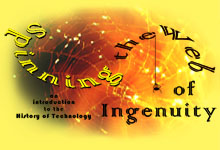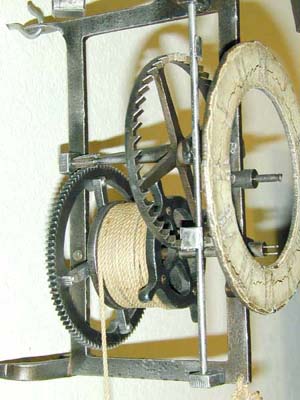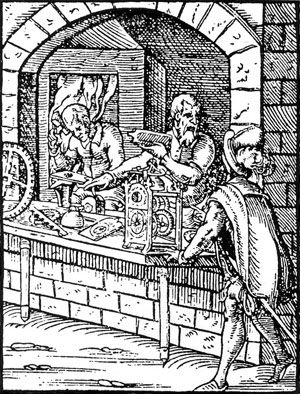
University of California, Irvine
Instructor: Dr. Barbara J. Becker

|
Lecture 6. Measuring Time
|
| In the morning when I get up, the first thing I do is think to myself:
what am I going to do today? There are so many things: I count
them, think about them, and assign a time to each one....
I'd rather lose sleep than time.... It's important to keep track of the time, and to assign things by time, to stick to business and never lose an hour of time.... The person who knows how not to waste time can do just about anything. The person who knows how to make use of time, will be lord of whatever he wants. --Italian merchant (1433) |
|
| The cyclical motions of heavenly bodies along with periodic seasonal
changes provided early humans with regular patterns they could rely on
to mark useful intervals of time. As communities grew in size and
complexity, leaders sought ways to track, measure, and even standardize
units of time in order to better coordinate individuals' activities.
The earliest timekeeping instruments were based on a simple premise: that time is a continuous thing which flows in one direction. Sundials, clepsydras [from the Greek words kleptein, meaning "to steal" and hydor, meaning "water"], and sandglasses all made visible the gradual and seamless transitions between then and now, and now and whenever. Their simplicity in principle did not mean that they were always simple in their structure. In 1086, the Chinese emperor appointed Su Sung, a trusted administrative official, to head a project to create the best astronomical timekeeper ever built. Su Sung engaged the services of Han Kung-lien to design and construct the machine. The result, completed in 1094, was an elaborate clepsydra. The 40-ft high machine reproduced the motions of the sun, the moon and certain stars by turning a pair of large celestial globes by means of a complex system of gears driven by a regulated waterwheel.
Diagram showing the inner workings of the astronomical timekeeper Su Sung presented to the emperor of China in 1094. Nothing remains today of this wonderful machine. It was dismantled and removed from Kaifeng in 1126 by Tatar invaders who were apparently unable to reassemble it. Su Sung's illustrated book on the timekeeper was reprinted in 1172, but memory of it and the remarkable device it described were lost until a copy resurfaced briefly in the 17th century and again in the 19th century. It was not until the mid-20th century, when, thanks to the research of noted historian of Chinese science and technology, Joseph Needham (1900-1995), we gained a full appreciation of the technological achievement this instrument represented. In the 13th century, an entirely new kind of time machine began to appear in the West. Called the verge-and-foliot, this clever device shifted the timekeeper's task from controlling the continuous flow of water or sand grains to noting the passage of small, discrete increments of time. Reputed by some to have been invented by the legendary canon, Gerbert d'Aurillac (c. 955-1003; later Pope Sylvester II), the verge-and-foliot relied on the spastic but regular oscillations of a weighted balance beam called a foliot [possibly derived from the French word folie,meaning "madness or folly"] about a vertical spindle called a verge [from the Latin word virga,meaning "stick or wand"]. |
 |
 |
| By the mid-14th c, elaborate astronomical clocks were being built.
They were described by designers in such detail that we have been able
to reconstruct working models in modern times.
Modern reconstruction of the astronomical clock (c.
1350) of Giovanni de' Dondi (1318-1389).
The reconstructed verge-and-foliot clock in Salisbury
Cathedral (1386).
Early mechanical clocks needed frequent resetting.
To set the clock to the "correct" time, astronomical sighting instruments
were used.
We know about early clocks because they were expensive. People who bought a clock kept records of their purchase. These records don't tell us much about how the clocks worked, but they do give us clues about the numbers of clocks that were built, what they were made of, who built them, who bought them, and how much they cost. Why did these early clocks cost so much? They were made of brass or iron which were valuable metals. They also took a long time for a clockmaker to build. Initially, individuals could not afford to have a clock of their own. Whole communities raised the necessary money to pay a clockmaker to build a timekeeper that everyone could use to organize their daily routines. Once built, the clock would be placed atop a high tower. This was not so people could see what time it was, but so they could hear it. The earliest community clocks had no faces or hands like our modern ones. In England, a mechanical timekeeper that you had to look at in order to tell the time was sometimes called a "watch," a word that comes from wachen, a German word that means to be awake and alert. To use a watch meant always having to keep it in view. The English word "clock" comes from the same root as glocke, the German word for bell. Timekeepers called "clocks" were designed to be listened to, not "watched." To be sure everyone in the neighboring countryside could hear the time, clockmakers placed huge bells in the clocktower so the sound would travel far and wide. In those days, the clockwork itself didn't ring the big bells -- people did. The clock mechanism would strike a small bell inside the clocktower to wake up the bell-ringer in time to sound out the hour! A village clock required constant attention to keep it working. Someone had to make sure it was always properly wound and set. Parts had to be regularly cleaned and repaired. In spite of the best of care, it was always possible for a clock to break down unexpectedly. Getting it working again could mean simply replacing a worn or broken part. However, it could also mean a complete overhaul of the entire machine. |
|
The clock repairman. →
With much chatter [the clock repairmen] tell how they have adjusted the gears, restored the equilibrium, reset the time, put in order many parts of the mechanism, and removed the rust; in short, having timepieces in hand for a month they pretend to have worked on them often, while in fact they just looked at them hanging on a wall or shut in a drawer. --Fifteenth century clock-owner |
 |
| The cost and frequency of clock repair gave clockmakers two good reasons to improve the design and construction of their clocks. But there were others. Individuals wanted to have their own personal timepieces. The growth of exploration and trade in the 15th c brought new uses for clocks, uses that required clocks to be smaller and portable, to be able to measure smaller units of time with greater accuracy. |
|